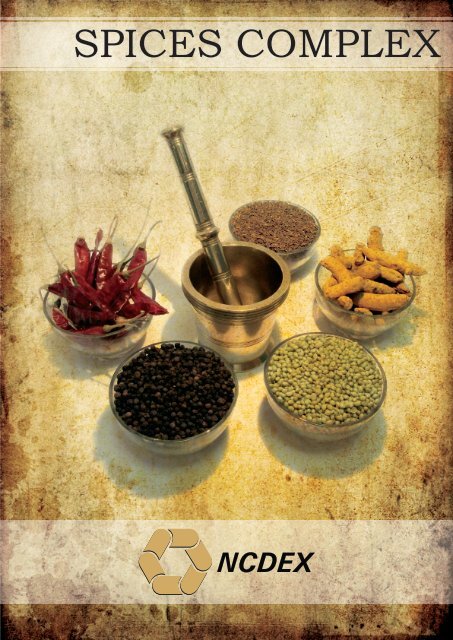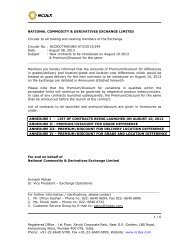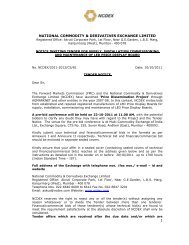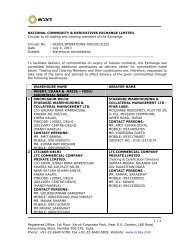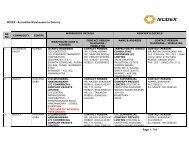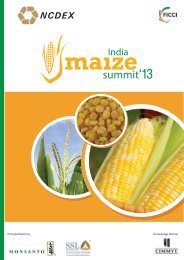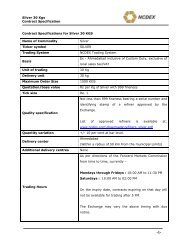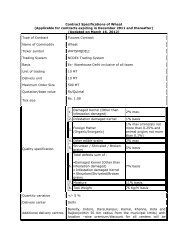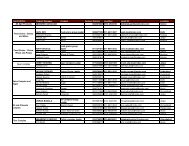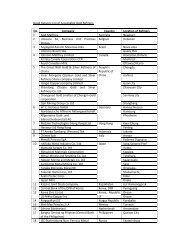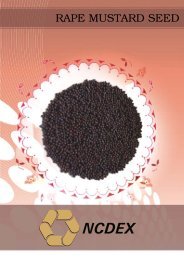Create successful ePaper yourself
Turn your PDF publications into a flip-book with our unique Google optimized e-Paper software.
SPICES COMPLEX
SPICES<br />
Spices form an important ingredient of Indian cuisine. The delightful combination of the variety of <strong>spices</strong> lends a distinctive<br />
<strong>spices</strong> futures on its platform for managing price risk and providing an alternative investment avenue. Chilli, Coriander,<br />
Jeera, Pepper and Turmeric constitute <strong>NCDEX</strong>’s spice <strong>complex</strong> for derivatives trading. The performance of these contracts<br />
India is the leading producer, consumer and exporter of <strong>spices</strong> in the world. From time immemorial India has been known<br />
as the Land of Spices. The Chinese, Arabs and The Europeans came to the Indian shores lured by the <strong>spices</strong> grown here. The<br />
world consumption of <strong>spices</strong> is growing steadily year on year and trading in Spices Futures has also grown from strength to<br />
You can trade in Spices futures by either becoming a member of <strong>NCDEX</strong> or a client of one of the members<br />
of the Exchange.<br />
PEPPE<br />
R<br />
APRIL 2004<br />
TURMERIC<br />
JULY 2004<br />
JEERA<br />
FEBRURY<br />
2005<br />
CHILLI<br />
MARCH<br />
2005<br />
CORIANDER<br />
AUGUST<br />
2008<br />
F<br />
• Global and Domestic Production /Demand<br />
• Import/Export Data<br />
• Total Deposited Stock & FED wise stock position<br />
• Climatic conditions<br />
• Daily Arrivals and trades in the cash market<br />
• International Price parity<br />
• Year ending stocks and stocks-to-consumption ratio<br />
• Prices received by farmers for other competing crops & Sowing progress<br />
• Cost of Carry components (Warehousing, Assaying, Demat/Remat charges)<br />
• Spot Prices<br />
• Daily Margins<br />
D<br />
• Spices are used in the dry, fresh and powder forms and are also used to make oleoresin.<br />
• All <strong>spices</strong> are used as a<br />
agent for culinary purposes and form an important ingredient<br />
of curry powders and Indian recipes.<br />
• Spice powders are used as colouring agent for processed foods<br />
• Spices are being extensively used in medical, Pharmaceutical, Cosmetics & Food Processing<br />
Industries.<br />
2
EXPORTS<br />
FROM I NDIA<br />
(APR-JUN<br />
2011) TONNES<br />
CHILLI - 40,500<br />
TURMERIC - 21, 775<br />
CORIANDER - 7, 500<br />
CUMIN - 5,750<br />
PEPPER - 5,750<br />
SPICE UP YOUR INVESTMENT PORTFOLIO<br />
50<br />
40<br />
30<br />
20<br />
10<br />
0<br />
Top Performing Spices<br />
Returns in Jan-July 2011 (%): Near Month Futures<br />
Best<br />
Performing<br />
Long<br />
Coriander<br />
Best<br />
Performing<br />
Short<br />
Turmeric<br />
SPICES FUTURES AS A TOOL TO MANAGE PRICE RISK<br />
24<br />
21<br />
18<br />
15<br />
12<br />
9<br />
6<br />
3<br />
0<br />
PRICE VOLATILITY<br />
Jan-09<br />
Mar-09<br />
May-09<br />
Jul-09<br />
Sep-09<br />
Nov-09<br />
Jan-10<br />
Mar-10<br />
May-10<br />
Jul-10<br />
Sep-10<br />
Nov-10<br />
Jan-11<br />
Mar-11<br />
May-11<br />
Jul-11<br />
DHANIYA PEPPER TURMERIC JEERA CHILLI<br />
Source: <strong>NCDEX</strong> (Monthly volatility calculated on the basis of spot prices of base centre<br />
KNOWLEDGE EDGE<br />
Plantation- Harvest Calendar: India<br />
Spices Jan Feb Mar Apr May June July Aug Sep Oct Nov Dec<br />
RED CHILLI<br />
CORIANDER<br />
JEERA<br />
PEPPER<br />
TURMERIC<br />
Harvest Planting Flowering<br />
The Plantation - Harvest Season may changed due to change in climatic conditions.<br />
3
SPICES @ <strong>NCDEX</strong><br />
Coriander (Dhaniya) – (Market size – 1100 Crores, HS Code 090920)<br />
Coriander, an annual rabi crop of the country is sown around<br />
About 80% of the production in India comes from Rajasthan.<br />
The other major producing states are Madhya Pradesh, Andhra<br />
Pradesh and Orissa. The Total Domestic production of the crop<br />
is around 2.5-3.00 lakh tonnes. Indonesia, Sri lanka,UAE, Saudi<br />
Arabia, USA, UK, Germany and the Netherlands are the major<br />
importers whereas India, Turkey, Egypt, Romania, Morocco, Iran<br />
and China are chief exporters. Popular grades of the rounded<br />
seed spice on the basis of colour are Badami, Eagle, Scooter<br />
and Parrot. Major trading centres of this<br />
spice include Kota, Ramganj, Baran and Jaipur in Rajasthan, Guna in<br />
Madhya Pradesh and Virudnagar in Tamilnadu. India is the largest producer, consumer and exporter of coriander.<br />
Chilli (Mirchi) – (Market size – 6954 Crores, HS Code 09042010)<br />
chilli<br />
and<br />
Cumin seed (Jeera) – (Market Size – 2050 Crores, HS Code 090930)<br />
Gujarat is the largest jeera producing state in the country,<br />
followed by Rajasthan. These two states alone contribute<br />
approximately 90% of production in the country. India leads the<br />
world production with around 2.0 lakh MT of Jeera produced<br />
annually and harvesting session of the crop is from February<br />
- April. Most of the Jeera produced is consumed within the<br />
country. Although Syria, Turkey and Iran have a much lower<br />
level of production as compared to India, but these countries<br />
4
prices as a bulk of their production is used for export purpose. Indian cumin is exported to many countries in its natural<br />
as well as powdered form, besides as an essential oil. The export of cumin seeds from India has increased manifold in the<br />
last five years. Jeera or cumin seed has significant demand as a spice all around the globe especially in the places where<br />
spicy food is preferred.<br />
Turmeric (Haldi) – (Market Size – 5758 Crores, HS Code 091030)<br />
Indian turmeric is considered to be the best in the world due<br />
to presence of high curcumin content. There are wide uses<br />
of this golden spice. Apart from its domestic culinary use, it<br />
processed foods. Turmeric is also an important ingredient in<br />
cosmetics as well as in the pharmaceutical industry. It is mainly<br />
cultivated in Andhra Pradesh, Tamil Nadu, Maharashtra, Orissa<br />
and West Bengal, with production ranging from 5.5-8.0 lakh<br />
tonnes and harvesting session is from February to April. The<br />
spice is generally available as “Fingers” and “Bulbs”. Some of<br />
the well known varieties of turmeric are ‘Salem’ and ‘Erode<br />
turmeric’ (from Tamil Nadu), ‘Rajapore’ and ‘Desi Cuddapah<br />
turmeric’ (from Maharashtra) and ‘Nizamabad turmeric’ ,‘Duggirala turmeric’, ‘Cuddapah turmeric’ and ‘Warangal turmeric’<br />
(from Andhra Pradesh).<br />
India is the largest producer, consumer and exporter of turmeric across the globe. The other major producers are China,<br />
Myanmar, Nigeria, Bangladesh, Pakistan, Sri Lanka, Taiwan, Burma and Indonesia.<br />
Pepper (Kalimirch) - (Market Size 803 Crores, HS Code 09041130)<br />
Black pepper is often referred to as black gold among <strong>spices</strong>.<br />
Pepper berries are usually dried and used as spice and<br />
seasoning. Black pepper is used directly as spice and also for<br />
the preparation of oleoresin and oil. Pepper grades in trade<br />
grades are Malabar and Tellicherry. In addition to these two<br />
Indian varieties, the major varieties traded in the world include<br />
Lampung, Brazilian, Ceylon, Sarawak and Vietnam.<br />
Vietnam with an annual production of almost double that of<br />
India, has now become one of the major suppliers of pepper<br />
in the international markets. However, Indian pepper fetches a<br />
premium price in major markets because of its preference and<br />
intrinsic qualities. India, Brazil, China, Indonesia, Malaysia, Sri Lanka, Thailand and Vietnam are major players in pepper<br />
production and exports. June-July is the harvesting period in Sarawak (Malaysia), August- September in Brazil, July-<br />
September in Lampung (Indonesia) and January-February in India. World Pepper production varies from 2.7 lakh-3.6<br />
lakh MT per annum whereas Indian production varies from 45,000 to 50,000 MT. Kerala is the leading state producing<br />
black pepper in India.<br />
5
VALUE CHAIN: ALL PARTICIPANTS IN THE VALUE CHAIN FACE THE PRICE RISK<br />
Farmer<br />
Commission Agent or<br />
Kachcha Adatia<br />
Trader or<br />
Pakka adatia<br />
Processor/<br />
Exporter<br />
Consumer<br />
Retailer<br />
Wholesaler<br />
SPICES FUTURES CONTRACTS SPECIFICATIONS<br />
Parameter<br />
CHILLI<br />
CORIANDER<br />
JEERA PEPPER TURMERIC<br />
Ticker Symbol CHLL334GTR DHANIYA JEERAUNJHA PPRMLGKOC TMCFGRNZM<br />
Unit of Trading 5 MT<br />
10 MT<br />
3 MT 1 MT 5 MT<br />
Delivery Unit 5 MT<br />
10 MT<br />
3 MT 1 MT 5 MT<br />
Quotation Base Value `/quintal* `/quintal* `/quintal* `/quintal* `/quintal*<br />
Tick Size Re. 2<br />
Re. 1<br />
Re. 1 Re. 1 Re. 2<br />
Maximum Order Size 250 MT<br />
500 MT<br />
150 MT 50 MT 250 MT<br />
Basis Centre Guntur<br />
Kota<br />
Unjha Kochi Nizamabad<br />
Additional Delivery Centres<br />
Warangal<br />
Ramganj Mandi,<br />
Jaipur, Guna,<br />
Baran<br />
Delhi, Jaipur,<br />
Jodhpur<br />
Calicut, Trissur<br />
Erode, Sangli,<br />
Warangal,<br />
Duggirala,<br />
Cuddapah<br />
Grade<br />
Member’s<br />
Position<br />
Limit (MT)<br />
Client’s<br />
Position<br />
Limit (MT)<br />
Delivery Logic<br />
Compulsory delivery of contracts implies that all open position at the expiry of contract need to be settled<br />
www.ncdex.com.<br />
6<br />
Badami<br />
Machine Clean<br />
Jeera<br />
All Contracts 12500<br />
7500<br />
3000<br />
Near Month<br />
All Contracts<br />
Near Month<br />
LCA 334<br />
(2500)<br />
4000<br />
(800)<br />
Compulsory<br />
Delivery<br />
(1500)<br />
2500<br />
(500)<br />
Compulsory<br />
Delivery<br />
(600)<br />
1000<br />
(200)<br />
Compulsory<br />
Delivery<br />
Malabar<br />
Garbled- 1<br />
4500<br />
(900)<br />
1500<br />
(300)<br />
Compulsory<br />
Delivery (Early<br />
Delivery)<br />
Unpolished<br />
Finger<br />
20000<br />
(4000)<br />
5000<br />
(1000)<br />
Compulsory<br />
Delivery<br />
(* : quintal=100 Kgs)
MAJOR AREAS OF SPICES PRODUCTION<br />
7
TRADING STRATEGIES<br />
Hedging<br />
Sugandh Exporters has an export commitment<br />
of 30 M T of Jeera for delivery in December<br />
2011 contracted at `15,500 per quintal.<br />
The exporter faces the risk of jeera prices<br />
going up. As soon as he enters into export<br />
contract, he buys 10 contracts of December<br />
2011 expiry Jeera futures at existing price of<br />
15,000 per quintal. In the month of December,<br />
price of jeera in spot market (as well as in<br />
futures on expiry) becomes `16000 per quintal.<br />
He incurs a loss of `500 per quintal in<br />
meeting the export obligation but gains<br />
`1000 per quintal in futures market. Thus, he<br />
manages to hedge from adverse price risk by<br />
taking corresponding positions in futures<br />
market.<br />
Cash & Carry Arbitrage<br />
Tikharam has no direct exposure to dhaniya<br />
trade; however, he has interest in commodity<br />
investment. He finds out that dhaniya december<br />
2011 futures are trading at `6000 per quintal<br />
and current spot price is `5200 per quintal.<br />
He noticed that after accounting for cost of<br />
carry (assaying, storage, interest etc), his cost to<br />
deliver in december is around `5900 per quintal.<br />
He procures 10 MT from local mandi today<br />
and deposit it in <strong>NCDEX</strong> accredited warehouse.<br />
At the same time, he sells 1 dhaniya futures<br />
contract of december expiry on <strong>NCDEX</strong>. At<br />
expiry, Tikharam delivers dhaniya and realises<br />
the profit of `10,000.<br />
Swadumal is a keen observer of futures price of<br />
pepper traded at <strong>NCDEX</strong>. From his experience<br />
over the years, he knows that normally the<br />
prices of January expiry contract exceeds that<br />
of December contract by around `500.This<br />
difference is called 'spread' in trade terminology.<br />
Due to some fluctuation in market, this<br />
spread shrinks to `300. Swadumal believes that<br />
eventually the spread will resume normalcy<br />
and increase to around `500. He, therefore,<br />
buys 1 contracts of january Pepper and shorts 1<br />
contracts of December pepper. In a few days,<br />
spread widens to `450. He squares off his position<br />
in both the contract and realises the profit<br />
of ` 1,500.<br />
Speculation<br />
Ms. Mirchi has through understanding of the<br />
fundamentals of chilli trade and keeps a<br />
continuous track of domestic and internationall<br />
developments that affect the price of chilli.<br />
In the Present scenario, she is convinced that<br />
the price of chilli is likely to increase in coming<br />
months. She takes a long position by buying 5<br />
futures contracts of <strong>NCDEX</strong> chilli for far month<br />
at `9,000 per quintal. In few days, the price<br />
increases to `10,000 per quintal and she<br />
squares off her position and locks in the profits.<br />
Contact our Business Team (Spices) for any query/information:<br />
SRIKANT AMBATI (HYDERABAD) + 919951922000 ANUP RAJ (DELHI) +919958110086<br />
JITENDRA SINGH (JAIPUR) +919983325699 VIKRAM SINGH (KOLKATA) +919051454777<br />
SREEKANTH CHETTIYAR (KOCHIN) +919946761411 SANDEEP DUBEY (HYDERABAD) +919949152475<br />
ANIL JAISWAL (AHMEDABAD) +919898066934 BHARAT JAKATI (MUMBAI) +919833255348<br />
DEEPAK SAYANA (HYDERABAD) +919848220310 TARUN KATOCH (INDORE) +919754417054<br />
GAURAV MIDDHA (DELHI) +919711159060 T. UMESH (JAIPUR) +918239101000<br />
AMIT DARAK (MUMBAI) +919819179128<br />
8


